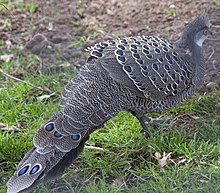Polyplectron bicalcaratum
| Grey peacock-pheasant | |
|---|---|
 |
|
| At Birmingham Nature Centre, England | |
| Scientific classification | |
| Kingdom: | Animalia |
| Phylum: | Chordata |
| Class: | Aves |
| Order: | Galliformes |
| Family: | Phasianidae |
| Subfamily: | Argusianinae |
| Genus: | Polyplectron |
| Species: | P. bicalcaratum |
| Binomial name | |
|
Polyplectron bicalcaratum (Linnaeus, 1758) |
|
| Diversity | |
| 3–4 subspecies | |
| Synonyms | |
|
Pavo bicalcaratus Linnaeus, 1758 |
|
Pavo bicalcaratus Linnaeus, 1758
Polyplectron chinquis Temminck, 1815
The grey peacock-pheasant (Polyplectron bicalcaratum), also known as Burmese peacock-pheasant, is a large Asian member of the order Galliformes. It is the national bird of Myanmar.
It is a large pheasant, up to 76 cm long and greyish brown with finely spotted green eyespots, an elongated bushy crest, bare pink or yellow facial skin, white throat, and grey iris, bill and legs. The sexes are rather similar, but the female is smaller, darker and less ornamented than the male. The young resemble the female.
The grey peacock-pheasant is distributed in lowland and hill forests of Northeast India and Southeast Asia, but excluding most of Indochina as well as the entire Malayan Peninsula. The diet consists mainly of seeds, termites, fruits and invertebrates. The female usually lays two eggs.
Widespread throughout its large range, the grey peacock-pheasant is evaluated as a Species of Least Concern on the IUCN Red List of Threatened Species. It is listed on CITES Appendix II, restricting trade in wild-caught birds to preserve its stocks.
Three subspecies are recognized today as good, while an additional one is of unclear validity:
One previous subspecies, the Hainan peacock-pheasant (P. b. katsumatae), has since been given approved species (AS) status by the IOC.
...
Wikipedia

